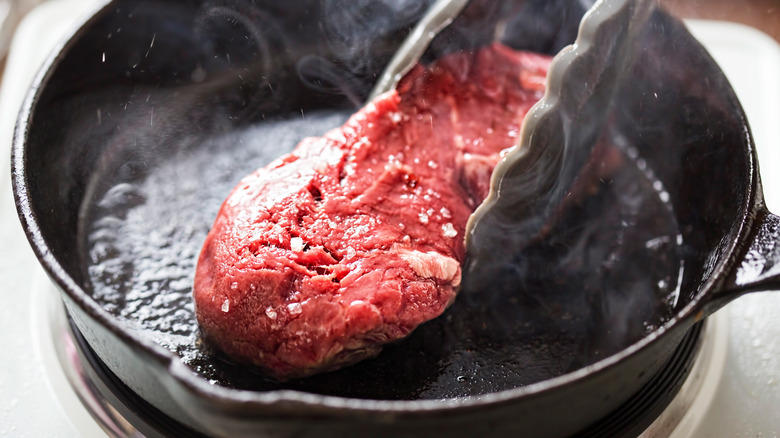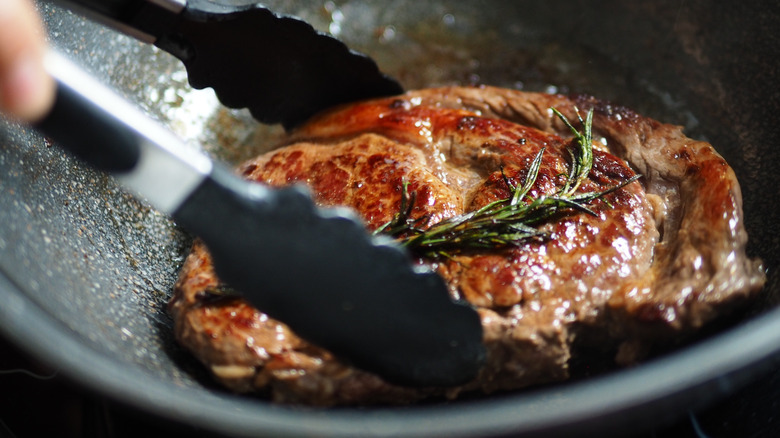Gordon Ramsay's Tip For Not Burning Yourself When Making Steak
When cooking at high temperatures, it's not just the food that's at risk of being burned; you need to avoid injuring yourself, too. And when searing steak in a pan, that risk is especially great because you're adding the beef to a very hot surface, and you also need to flip it over to cook both sides. Moving a potentially fairly large and heavy piece of meat, depending on the cut you're cooking, means your hot cooking oil as well as the fat from the steak is prone to splashing and spitting.
Luckily, Gordon Ramsay has a top tip to help, and it's all about the way you lay the meat in the pan. Rather than laying it towards you, which risks the oil splattering in your direction, the chef recommends laying it away from you instead. It's a simple trick, but one that is well worth remembering for your next steak night.
Different meats require different approaches when it comes to heat. While you should never use a hot pan to cook bacon, instead starting it off in a cold pan, steak needs a fiercely hot surface to begin with. The pan should be at least 375 degrees Fahrenheit – ideally hotter. That's what helps give it that deliciously browned crust. And by following Ramsay's advice, it means only the beef will be sizzling, and not your skin.
Lay the steak away from you to stop hot fat splashing
Gordon Ramsay's tip can be applied when cooking different cuts of steak, and it starts with the moment you add the meat to the pan with the hot oil. Place the edge of the steak in the front of the pan, and then gently lay it down in the opposite direction to you. The chef advises letting it develop a nicely caramelized crust by patiently leaving it to sear on one side, and then carefully turning it over to repeat the process on the other side.
As well as searing both sides of the meat, it's also important to cook the edges. And for this, Ramsay's technique is to tilt the pan away from you. Use tongs to hold the meat vertically with the edge of the steak against the far side of the hot pan, lifting up the handle so that the pan is at an angle pointing down towards the stovetop. This will help prevent hot oil, as well as any fat from the edge of the meat, from spitting in your direction.
To avoid excessive splattering, as well as the kitchen from filling with smoke, be wary of the oil mistake everyone makes when cooking steak. Use a vegetable oil that has a high smoke point, and you can always brush the steak with oil rather than add the fat to the pan if you want to reduce the amount.
How often should you flip a steak during cooking?
Gordon Ramsay's method for cooking a steak is a common technique: Sear one side, wait, flip the meat once, wait again, and then sear the edges. But others prefer to flip it more often and turn it as often as every 15 to 30 seconds. And while the idea behind only turning the meat halfway through is to develop a caramelized crust thanks to the longer time on the heat, there are advantages to frequent flipping, too.
Turning the meat multiple times during cooking actually helps it to cook more quickly. This is because the steak remains at a more uniform temperature all over during the process, with both sides repeatedly exposed to heat, rather than turning once to cook the cold side essentially from scratch. It cooks more evenly, and in less time, and can also reduce the risk of the steak developing a gray edge. Just ensure your pan is hot enough, and you should still develop the same delicious browned crust as when turning once.
Whichever method you prefer, remember that it matters which side of the steak you cook first, so lay the fattier or more marbled side down to start with so the fat has a chance to render. Just follow Ramsay's advice to lay it away from you, for a safe as well as tasty result.



